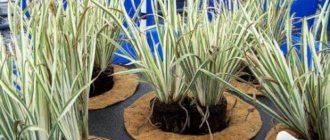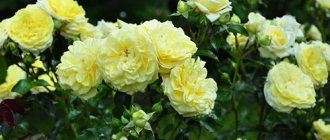Irises can decorate any flower bed and garden plot. Dwarf plant varieties are used for borders, and tall varieties are used for planting next to hedges. They are unpretentious in care and can take root on any type of soil. Siberian iris is frost-resistant, so it can be grown in middle and northern latitudes.
Siberian iris - description
The crop belongs to the category of perennial plants. It can bloom and delight the eye with bright colors for decades. Iris or Siberian iris is grown even in the northern regions of Russia, because it is resistant to cold and various diseases. The most common color of the buds is pale blue or blue. Less common are varieties with milky, cream or pink petals.
The only drawback of Siberian irises is the lack of smell. However, it is compensated by abundant and bright flowering. Each bud has six petals, three of which point down and the rest point up. The duration of flowering of the Siberian iris is from 12 to 15 days. In order for the crop to please the eye with bright colors longer, you can plant different varieties with early and late growing seasons nearby.
When does the Siberian iris bloom?
The varieties differ not only in the shade of the buds and height, but also in the growing season. The hybrid white Siberian iris blooms in June. However, most varieties bloom in July-August. Flowering time depends on the variety and on where the crop was planted. The less sunlight a plant receives, the later it blooms and the fewer buds it produces. Breeders have developed remontant varieties, which bloom twice a year - in spring and early autumn.
What is the difference between bearded iris and Siberian iris?
Flowers of this type are divided into two large groups: with and without a beard. Siberian iris belongs to the second category. It differs from bearded (German) varieties in that it is unpretentious to the conditions: it grows in soils with any acidity and can bloom even in partial shade. Another distinctive feature of the iris is the absence of a jointed neck. Unlike bearded irises, Siberian irises do not tolerate fertilizers that contain calcium.
Both plant varieties are resistant to root rot caused by fungal pathogens. Flowers also differ in the external characteristics of their buds. Bearded iris flowers have inconspicuous shades. The buds of iris are distinguished by bright tones. They attract the attention of others, but are small in size. Yellow Siberian iris is less common in nature.
A few words about irises
The genus of irises includes up to 200 species! Only a few are grown in our climatic conditions - many species and varieties are not frost-resistant enough. All irises are divided into:
- bulbous,
- rhizomatous (bearded, beardless).
Although there is considerable variation between species, garden irises are easy to recognize. Irises have a distinctive feature - the plants produce numerous dark green sword-shaped leaves that grow from the ground. In the cluster of leaves grow fleshy stems, at the top of which a huge, eye-catching, colorful inflorescence appears. Irises bloom for about a month, the greatest intensity of flowering occurs in May. To maximize the flowering period, choose varieties with different flowering periods: early, middle and late.
This is interesting! All about the varieties of irises - an article with photographs about the classification of irises and varieties.
The flower consists of several colored petals pointing upward and several gently hanging down. The inner portions of the cup usually rise up and touch each other, forming a dome. An inflorescence with a very complex structure, making the flower exotic.
The most common are bearded garden irises (rhizomatous). Their peculiarity is that on the surface of the outer sections of the calyx, along the vein, the petals are covered with tiny hairs resembling a “beard”. The flower blooms in May–June and produces beautiful, large flowers of different colors. This perennial plant produces several stems, so even one rhizome planted in the garden can create a real bush of flowers. The flower is usually decorated with a yellow or brown beard.
Siberian (iris sibirica) deserves attention. As the name suggests, Siberian irises are native to Siberia. This amazing plant will brighten up any garden. The species is tall, like a bearded one, but due to its smaller leaves and flowers it looks different. The flower produces numerous sword-shaped leaves. The plant produces many flowers - usually blue, blue, the flowers are slightly smaller than the bearded ones.
Let's consider the features of growing bulbous and rhizomatous irises. Particular attention should be paid to species differences, since the conditions for planting and growing some species are fundamentally different.
Siberian iris varieties
A distinctive variety of winter-hardy plants is their neat leaves and tall stem (up to 120 cm). In order to become better acquainted with the characteristics of the plant, it is necessary to consider the most popular varieties that gardeners love:
- Alba
. The flowers have a lemon-cream hue. They bloom at the beginning of summer and may not fall for a long time even in bad weather. - Ego
. It belongs to the dwarf breeds, not exceeding 80 cm in height. Siberian blue iris blooms in July, but no buds appear in the first year. - Big Ben
. Iris is distinguished by its bright purple buds, reaching 7 cm in diameter. It grows well only with sufficient light. - Double Standard
- double iris flowers have two shades: lemon in the middle and dark purple at the edges. Their bloom is observed from July to August. - Concorde Crash
. In terms of external characteristics, the flowers resemble the Double Standard variety, but they bloom much earlier. Siberian iris Concord Crush blooms in late May-early June. - White Swell
is a dwarf variety that grows up to 60 cm. The buds are distinguished by snow-white shades without inclusions or additional flowers. Iris grows exclusively in sunny areas. - Cambridge
. Iris buds have a soft blue tint with a yellowish spot at the base. They require sunlight to bloom well.
Characteristics of species and varieties
Bearded iris: planting and care in open ground
Each varietal hybrid of irises is worth having in your flowerbed. Below is a description of the most popular representatives of this group of killer whales.
Varieties of Siberian irises
| Name | Peculiarities |
| Irises Concord Crush | Blue-violet flowers with a diameter of 15 cm are formed on meter-long stems. At the base you can see a light yellow center. The variety is unpretentious and develops well even in a shaded place. |
| Moon Silka | The stem is low - barely reaches 90 cm. The size of the flowers is small - 10 cm in diameter. Attracts with the color of the petals - the extremes are light yellow, turning into an orange tint at the base. The inner petals are soft white with a slightly perceptible creamy coating. Prefers to grow in a well-lit place |
| Miss Apple's Irises | A graceful representative of the species with large multi-petaled flowers. The middle ones are painted in violet-lilac tones, the outer ones are rich burgundy with a yellow ornament at the base |
| Iris Germanskiy Sia Double | It stands out in the flowerbed with rich blue shades with individual blue petals. Irises Sia Double are winter-hardy and develop well in partial shade, producing large buds (up to 15 cm) on meter-long stems |
| Iris Pink Parfate | A distinctive feature of this variety is that its pale lilac flower is similar in structure to a rose, which makes it especially popular among gardeners. Starting to bloom in June, exudes a strong aroma for 1.5-2 months |
You can find many more varieties of Siberian irises, distinguished by blue, light blue, violet, lilac, and white shades. To those already described in the table, you can add Kita no Seiza, Having Fan, Harpswell Happyness, Butter and sugar, Sparkling Rose, Hubbard, Imperial Opal, Kaboom, Double Standard.
Siberian iris - planting
The procedure is carried out in August or early September, but the first ten days of May are also allowed. Planting outside the schedule can cause disease and death of the flower. Crops placed in open ground in late autumn are more difficult to adapt to external conditions. These rules apply to all varieties, regardless of whether Siberian yellow or white iris is planted. A distance of 60-70 cm is left between individual specimens.
Holes are made in a pre-prepared area. Their depth should correspond to the length of the iris roots. It is important that they do not bend or break. The seedlings are placed vertically, and then they are sprinkled with soil and the soil is compacted around the flower. After planting, the plant is watered. In order for the plant to take root better, the ground around it is covered with mulch: peat or compost.
Soil for Siberian irises
Perennial crops grow for a long time in one garden plot, so it is recommended to plant them in fertile soil. Flowers, especially the Siberian iris Lemon Vale, prefer loamy soil with a neutral or slightly acidic composition. It is recommended to add sand to heavy soil before planting. It's important not to overdo it. Too much sand will negatively affect the growth and fruiting of irises.
Other rules for correcting soil for planting crops:
- in swampy areas, high-quality drainage is organized at the site where irises are planted;
- organic fertilizers and clay are added to sandy soils;
- peat is added to the soil with an alkaline environment.
Features of the view
Irises of this species are unique; this crop grows equally well in the Krasnodar Territory and in the Urals.
Choosing a site for a flower garden
Irises love light. But in the middle zone, you need to choose an open area, and in the south you should give preference to a location where the flowers will be well lit only in the morning or evening; lightly shaded areas are also suitable.
Flowers will not die if there is little light, but they will stop blooming. The less light there is, the fewer colors there will be. The bushes of this flower crop grow densely, they do not fall apart in strong winds.
What kind of soil is needed
There is an opinion that irises can grow in any soil, the main thing is to avoid alkaline and acidic soil. The rest of the soil can be improved.
The ideal soil would be soil with neutral acidity and fairly dense. The soil must retain moisture well. For example, loamy soil, to which you need to add a large amount of humus.
On an area where the soil is well moistened, other types of irises will not grow, but Siberian ones can. It is enough to make high-quality drainage. If the soil is sandy, you can improve it by adding organic fertilizer.
Important! Siberian irises themselves have an unusual ability to improve the condition of the soil, disinfecting it.
In areas with excessively dry soil, frequent watering must be included in the maintenance.
What to plant irises with
Siberian irises tolerate well the proximity to lilies and other flowers of the lily family. And against the backdrop of orange blooms, these flowers look simply magnificent.
It is recommended to plant irises on lawns in small groups of different varieties. You can plant oriental poppies, or hosts, or peonies nearby. You just need to make sure that the lawn grass does not interfere with the growth of flowers.
Often these flowers are used to decorate a pond. They look natural, reminiscent of reeds. High soil and air humidity are ideal conditions for these beautiful flowers.
How to choose planting material
When choosing planting material, you need to pay attention to the root system. Roots often dry out if they do not receive proper care. It is better to give preference to iris rhizomes that are in pots. And it is more profitable to buy irises grown in nurseries.
Rhizomes that are placed in a plastic bag with the addition of sphagnum moss are also suitable. It is a natural antiseptic and retains moisture well. Sometimes the rhizomes are sprinkled with peat. But this material cannot be called the best, since irises often get sick and dry out while in peat.
You should not buy irises to plant near the road. There is a chance that instead of hybrid varieties they will sell you regular irises.
Caring for Siberian irises
Growing iris includes loosening the soil, weeding, sanitary pruning and fertilizing. Siberian iris, planting and caring for which will not cause difficulties, requires regular watering. The flower does not like dry conditions. Irises should not be flooded, because in this case weeds will actively grow. The right time to moisten the soil under the crop is early morning or evening.
Siberian iris - feeding
Fertilizer is another important plant care procedure. Some varieties need to be fed once a year. Siberian iris Kaboom requires fertilization in several stages:
- When the first greenery appears on the bushes. In this case, mineral substances are used: “Kemira”.
- During the period of bud formation. Use compost or fermented grass.
- After flowering, phosphorus-potassium substances are added to the soil.
Rules for caring for and growing in the garden
Siberian irises are one of the most unpretentious decorative flowers for planting in open ground. They can enter the growing season even without any care; with minimal care for planting, it is easy to achieve abundant and long-lasting flowering. The flower is suitable even for novice gardeners, and is also recommended for decorating areas in the northern regions.
Watering
Immediately after planting, plants require regular and abundant watering up to 3-5 times a week. After the irises form powerful rhizomes, the amount of watering should be reduced to 1-2 times a week. The water must be no lower than ambient temperature; before the procedure, it should be settled or rainfall should be used.
Irises tolerate drought well, but it is advisable to regularly check the top layer of soil for the presence of a hard crust, which should be loosened for aeration.
Top dressing
Proper application of fertilizers allows you to enhance flowering and achieve the formation of a large number of flower stalks on one plant. Fertilizing is applied twice per season - in the spring after the snow melts, then during the formation of flower stalks.
Regardless of the period, it is recommended to use only a complex mineral composition for flowering plants, which contains all the necessary elements.
When growing on poor soils, additional fertilizing with organic matter can be done. Most often, a water infusion of mullein or bird droppings is used in a ratio of 1:10.
Loosening, mulching
As a dense crust forms on the top layer of soil, it is advisable to carry out loosening, combining it with weeding. The procedure should be done very carefully, trying not to damage the rhizome with a sharp instrument. You need to loosen the soil to a depth of 3 cm to increase the aeration of the substrate.
Throughout the season, it is recommended to maintain a layer of mulch, which retains moisture on the surface and additionally warms the lower parts of the plant during sudden temperature changes. The mulch layer should not exceed 5 cm; peat or hay is used as the material.
Pinching, pinching, pruning
As the buds fade, they must be removed in a timely manner to enhance the shade and duration of flowering of other flowers. The procedure is best done by hand, since the tool can easily damage the leaves and stem of the plant.
Before the onset of severe cold weather, it is necessary to prune flowers for the winter. To do this, leave up to 10 cm above the ground level, and the rest of the plant should be completely cut off and destroyed. If you did not carry out the procedure in the fall, you can leave it until early spring and trim the irises a few days before the first feeding.
Transfer
Siberian irises are the longest-living among all varieties of this crop. In comfortable conditions and with minimal care, flowers can live in one place for up to 30 years without the need for replanting. The procedure is carried out only in case of mass infection of plants or if it is necessary to move the flowerbed to a new location.
Transplantation is carried out at the end of summer or early spring after flowering has ended and the plant has entered the dormant stage. It is necessary to trim the bush almost at ground level, and then carefully dig out the rhizome.
After this, the irises are transferred along with a lump of earth to a new place in previously prepared holes. If a cold winter is predicted, then during this period they can be left in a cool and dark room in large containers, regularly moistening the soil as it dries.
When to replant Siberian iris?
A crop cannot grow in one area for more than 15 years. The roots of old bushes take away useful microelements from the soil and do not allow seedlings to develop normally. Some varieties, such as the Siberian iris Imperial Opal. replanted every 5-6 years. They try to remove old rhizomes from the soil so that they do not take up space. The optimal time to transplant iris is 2-4 weeks after the petals wither.
Algorithm for the procedure:
- Peduncles and leaves are shortened by 1/2 the length.
- The iris is divided into several bushes and planted in new areas.
- The seedlings are buried in the holes by 5-7 cm.
Siberian iris - propagation
The procedure is carried out using rhizomes, not seeds. This is due to the fact that in the latter way it is impossible to transfer all the genetic material of the parent seedlings. This method of propagation is suitable only for those varieties that have been bred by breeders: Siberian iris I.C. Stars, Big Ben, Alba Natural species have the ability to self-pollinate. Their seeds, falling to the ground, germinate and produce the first shoots in the spring.
Irises growing in the wild are not suitable for planting in a summer cottage. This is due to their uncontrolled reproduction. Stages of the procedure:
- The bush is dug up and its rhizome is shaken off from adhering clods of earth.
- The roots are divided into parts. It is easier to carry out manipulations with 3-4 year old specimens. It is more difficult to divide mature bushes because their roots are strongly intertwined with each other.
- The roots of the planting unit are cut off (by 5-7 cm) and leaves by 2/3 of the length.
- The cuttings are immediately planted in a new place or dug in before being placed in the ground. Otherwise, they will dry out and become unsuitable for further use.
Preparing for landing
Planting is carried out in early autumn, starting in the second half of August or in the spring, immediately after the snow melts on the site. Before planting irises, you need to carefully dig up the area to at least the depth of a spade bayonet.
During digging, it is recommended to add organic matter, for example, compost or humus at the rate of 5 kg/m2. At the same time, it is recommended to adjust the acidity level. In addition, it is important to remove from the site all plant debris that may contain pathogens of dangerous diseases.
Siberian irises are usually planted with rhizomes, like other types of this plant. Before planting, they need to be cleaned and washed, and then the leaves should be cut to 1/3 of the length, and the roots should be shortened as much as possible. There is no need to soak the planting material or use a growth stimulator - the plant takes root well and begins to grow quickly.
Diseases of Siberian irises
If improperly cared for, the flower may die. Iris is not picky about care, but if overwatered or planted in the wrong place, it is susceptible to the following diseases:
- Bacteriosis
– rot of the root system. The development of the disease is facilitated by an excess of calcium in mineral fertilizers or abundant watering. Symptoms of bacteriosis: drying of the tips of the leaves, an unpleasant odor from the stem, slow growth of the specimen. It is impossible to save such a plant, but it is possible to prevent its infection by pre-treating the cuttings. - Fusarium
is a fungal disease manifested by yellowing and drying of iris leaves. The affected specimen is dug out of the soil and destroyed. - Gray rot
. A symptom of the disease is the formation of a light coating on the buds, leaves and stems. The lesions are especially noticeable on specimens with dark-colored flowers. These include Siberian iris Bundle of Joy and Concord Crush. You can save a sick bush. If you remove its damaged parts in a timely manner and treat it with fungicides.
Medicinal properties
In addition to being highly decorative, irises have healing properties. This feature is due to the unique chemical composition of plant fibers.
Among the valuable nutrients of the flower, vitamins (A, beta-carotene, E, C, K, B1, B2, B4, B5), micro- and macroelements (calcium, iron, phosphorus, potassium, sodium, zinc, copper, selenium) were found. as well as essential oils. Due to the high concentration of beneficial substances, plant bulbs are used in medicine and cosmetology.
- Their therapeutic effect is manifested in:
- protecting the body from premature aging;
- stimulation of the immune system;
- cell regeneration;
- antioxidant and antibacterial effects;
- pain relief;
- relieving nervous tension;
- astringent and homeopathic properties;
- the ability to remove phlegm from the body during inflammatory processes in the respiratory system;
- cleansing the blood and improving its formula.
Traditional healers advise using iris raw materials to make eye drops, expectorant and antimicrobial decoctions, as well as to relieve toothache, treat the pancreas, and the genitourinary system; healing of festering wounds and internal ulcers. It has been noticed that a decoction of Siberian iris can resist even the tuberculosis bacillus. However, with individual intolerance and illiterate use, it can only harm the body.
Important! The yellowed foliage of iris seedlings indicates that it has been pre-dried for several days. Such planting material is not suitable for long-distance transportation.
Pests of Siberian irises
The plant has pests that feed on its sap and sap. They cause iris disease or death. The list of insect pests includes:
- Slugs
. The worms are activated at night and feed on the stems and leaves of the plant. To protect the crop, add ash to the ground or treat the flower with tincture of hot pepper. - Aphid
. The insect drinks the sap of the plant and causes it to dry out. Siberian iris Cambridge and other varieties are sprayed with soda (0.5%) or karbofos (0.3%) to protect against the pest. - Thrips
. To combat the pest, summer residents use karbofos, diluted in water in a ratio of 75 g per 10 liters. - Nematodes
. Insects survive even in the cold season. To combat the problem, garden tools are treated with formaldehyde and the garden plot is weeded to remove weeds.
Pests and diseases
Under favorable growing conditions, this type of iris demonstrates high resistance to parasites, fungal and bacterial infections. And if basic agrotechnical rules are violated, gardeners may encounter the following bush diseases:
- bacterial rot (occurs due to an excessive amount of nitrogen in the soil, its pathogens are activated in the spring, manifested by brown soft spotting on the foliage);
- fusarium (the reasons for its development are improper care and excessive dampness in the soil, manifested by rotting of the root bulb);
- spotting (caused by moisture disturbances and an acidic soil environment, manifested by the formation of dark spots of various shapes on the leaves);
- root gray rot (pathogens are activated in the summer during prolonged rains, manifested by specific mold on the above-ground parts of the bushes, as well as by pale foliage).
To avoid illnesses in a flower garden, it is necessary to regularly inspect all its plants. Suspicion should be raised by any new growths on the stems, leaves or buds. Also, the disease is indicated by a lag in the development of bushes and any deformations on them.
Why do the buds of the Siberian iris dry out?
Another problem that gardeners may encounter is blackening of the inflorescences of the bush. They do not have time to bloom and immediately wither. Drying of buds occurs for two reasons: infection with root rot or damage to the bush by insects. The gardener needs to break the flower and examine it for pests. All damaged inflorescences are cut off and destroyed. A diseased specimen is treated with insecticides to avoid problems next year.
If there are no insect larvae in the inflorescences, this means that the flower is infected with root rot. The diseased specimen is sprayed with any fungicide. Siberian iris Miss Apple and other varieties can be saved with the help of Glyokladin. Several tablets of the drug are buried under each affected bush. When fighting root rot, it is also important to reduce the frequency and amount of watering.
Plant information
These flowers can be seen everywhere: from Europe all the way to the Far East. The common name of the species comes from the name of the goddess of the rainbow - Iris. This is no coincidence - there is such an abundance of colors among the iris varieties that, combining them on one plantation, it is easy to count all the shades of the spectrum.
Despite the name of the group, “Siberians” are selected mainly in Holland and Germany. The name reflects the ability of irises to winter in open ground even in harsh winter conditions.
The main purpose of iris is to decorate the landscape. Flowers look good in large rock gardens, on alpine hills, near ponds and courtyard buildings. It is enough to plant one root, and within a couple of years there will be a gorgeous bush in this place.
Siberian iris
Siberian iris is also a medicinal plant, in which the rhizome is the most valuable. This part of the flower contains essential oils, resins, starch, tannins, flavonoids, mucus, and sugars. This composition determines the widespread use of iris in folk medicine:
- healers call the raw material “tooth root”, which already determines the main use;
- decoctions and infusions are used for diseases of the upper respiratory tract, as an expectorant;
- for problems with the gastrointestinal tract, iris rhizome gives an enveloping effect;
- homeopaths recommend using medications for sciatica and migraines;
- Since ancient times, powder has been sprinkled on wounds for quick healing.
On a note! The official industry did not ignore this variety of irises. The crushed rhizome is used in the preparation of tooth powders and powders, medicinal plasters and cosmetics. The product has also found its place in perfumery - the essential oil ketone iron has a violet smell.
Siberian iris in landscape design
The culture has more than 100 varieties, differing in height and color. Siberian iris is used to decorate flower beds or mixed borders. In this case, low-growing specimens are placed in the foreground, and tall bushes with a length of 1.4 m in the background. Graceful plants will decorate any body of water, because they blend harmoniously with the coastal vegetation.
After flowering, it is not necessary to cut off the seed pods of irises. Shrubs add extra interest to landscaping. In large rockeries, irises are planted in groups according to the appropriate shade. Small summer cottages are decorated with miniature specimens. In order for low-growing varieties to grow, they need to be replanted and divided more often.
Wintering
Unlike other types of irises, Siberian varieties are highly frost-resistant. The plant can survive even severe frosts. But in order to avoid the death of the flower, it is necessary to trim the bush to a height of 10 cm, and then cover the planting with straw, agrofibre or spruce branches.
When growing irises in Siberia or the Urals, some gardeners dig up flowers for the winter and store them indoors until the beginning of spring, but this procedure reduces the plant’s immunity and worsens the quality of flowering.











